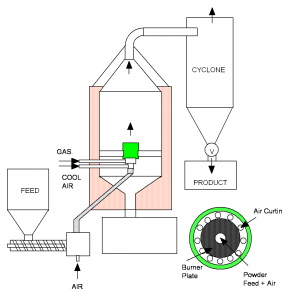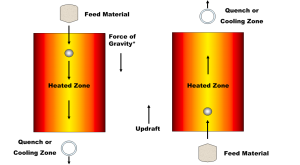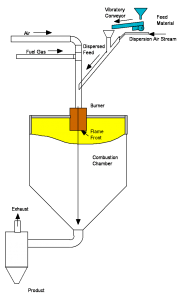Summary of Process
Feed material may be glass frit, other dry particles or solutions containing the forming components
Compositions are typically soda lime silicates, sodium borosilicates, etc.
Feed must contain a blowing agent
A blowing agent is a material that decomposes and releases gas at elevated temperature
Commonly sulfur-containing compounds
Feed material is introduced into a flame at elevated temperatures (~1100-1400°C)
Gas released by the decomposition of the blowing agent causes particles or droplets to expand to hollow glass microsphere.
SRNL has developed an experimental apparatus for forming HGMs based on this technique.
Particles may enter the flame by:
Falling downward due to the force of gravity
An updraft may be used to control the residence time in the flame
Particles have a short residence time in the heated zone
Conducive to HGMs with smaller diameters
Ascending upward by a gaseous stream
Residence time in heated zone is longer
HGMs with larger diameters are produced
For More Information:
Up Flow
Sodium Silicate Particles
US Pat. 2,978,339 F. Veatch Emerson & Cuming
Spray Drying Sodium Silicate Solutions
US Pat. 3,669,050 C. Henderson Emerson & Cuming
Glass Particles
US Pat. 4,661,137 P. Garnier Saint Gobain
US Pat. 5,256,180 P. Garnier Saint Gobain
Down Flow
Clay Particles
US Pat. 2,676,892 J.D. McLaughlin Ferro Corp
Glass Particles
US Pat. 3,365,315 W.R. Beck 3M Co.
US Pat. 4,391,646 P.A. Howell 3M Co.
US Pat. 4,767,726 H.J. Marshall 3M Co.
US Pat. 6,254,981 R.B. Castle 3M Co
 Feed is introduced at the bottom of the furnace
Feed is introduced at the bottom of the furnace
A hot, gaseous stream carries the feed upward
Residence time within the hot zone of the furnace is a function of:
Particle mass
Upward velocity of the gas stream
Residence time is critical – just enough time to form a “tough outer skin”
Hollow sphere must then be removed at the point of maximum expansion and moved through regions of progressively diminishing temperatures
“Outer skin” cools and solidifies providing mechanical strength
The cyclone separates the HGMs from the gases
HGMs are produced with diameters of ~10 – 350 μm
Feed is introduced at the top of the heating chamber by a vibratory funnel
A “fluidizing agent” may be added to the particles to improve dispersion
The particles are transported to the flame by a carrier gas
Carrier gas further disperses particles
Particles fall though the flame front where fusion occurs
HGMs are cooled and separated from the gas mixture by a cyclone
HGMs are produced with diameters less than 125 μm

